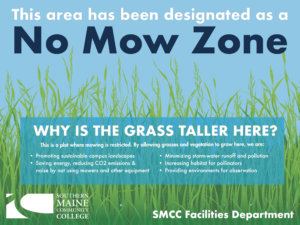
SMCC has created more than a dozen natural areas around the South Portland Campus that will no longer be mowed in an effort to save energy, reduce pollution and enhance wildlife habitat.
The grassy areas scattered across campus have been designated as “no-mow zones” and are marked with signs explaining why they are being left alone to grow naturally.
Allowing grasses and vegetation to grow promotes sustainable landscapes, saves energy, and reduces carbon dioxide emissions and noise by not using mowers and other equipment. No-mow zones also reduce storm-water runoff and pollution, provide environments for observation, and increase habitat for bees, butterflies and other pollinators.
“It’s amazing how much you can do by not doing anything,” said Science Professor Chris Hoffmann, who helped spearhead the no-mow zones idea with Instructor Christian Farnsworth.
Hoffmann and Farnsworth became interested in creating no-mow zones while serving together on the SMCC Sustainability Committee. Besides teaching science, Hoffman also co-teaches a Nature and Culture course. Farnsworth teaches photography at SMCC, and also teaches environmental science and photography at York County Community College.
Together, they ran the idea of establishing no-mow zones by President Joe Cassidy last summer. With the president firmly behind the concept, they collaborated with SMCC Environmental Health & Safety Coordinator Jen Otenti and the Facilities Department.
The College Council gave final approval to the plan in April, and the no-mow zone signs were installed in mid-June.
The zones are located across campus, including outside the Health Science Center, Jewett Hall, the Construction Technology Center and Hildreth Hall. Other no-mow areas are located outside the Captain’s House and Harborview Hall, and in grassy areas in and around different parking lots.

